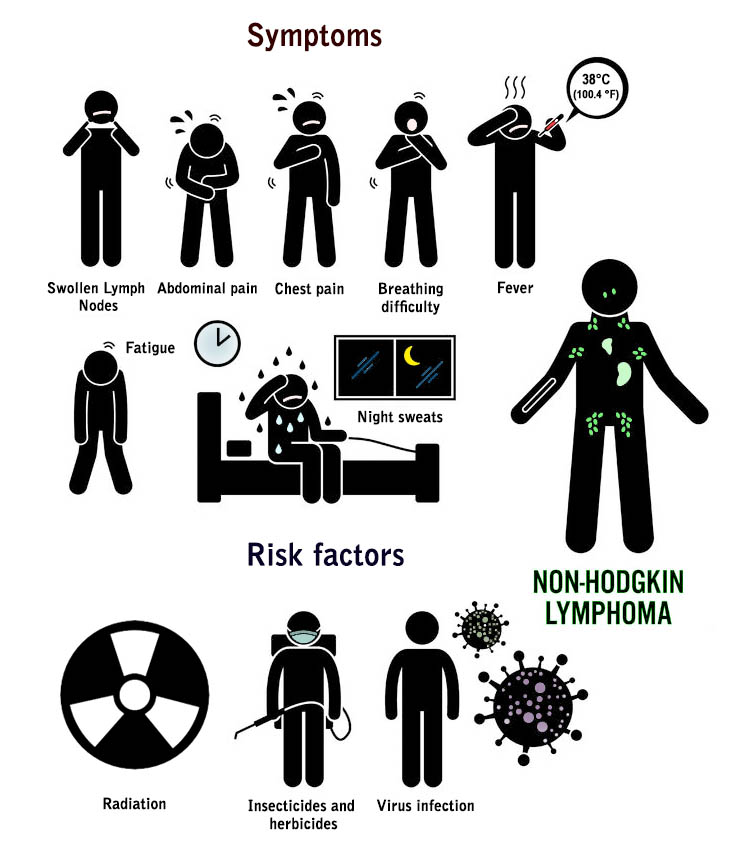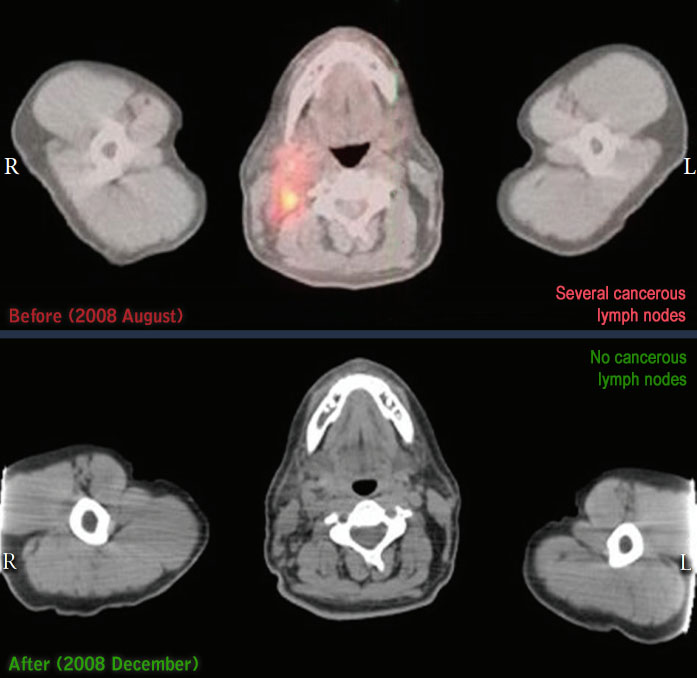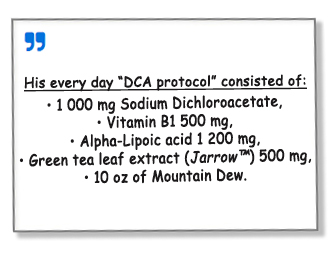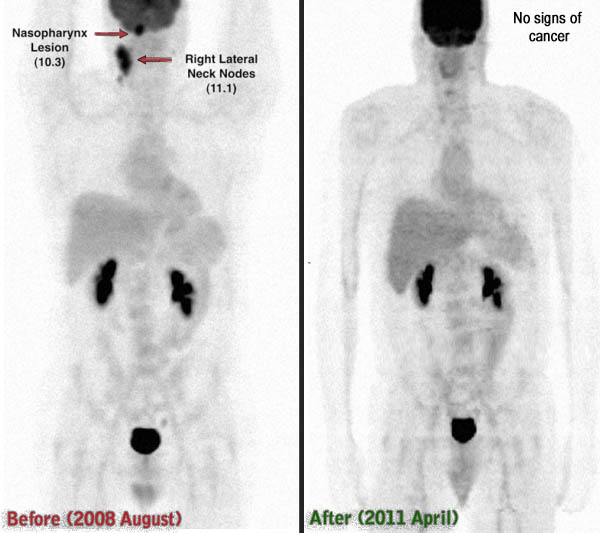Today we would like to present you our first article based on Dichloroacetate usage benefits as described in case series. This writing will focus on a middle aged man who managed to cure his IV stage Non-Hodgin lymphoma with the use of DCA.
But first – let’s briefly remember some important aspects of this cancer and Sodium dichloroacetate.
Non-Hodgkin lymphoma is a type of cancer that begins in the body‘s immune system cells – T or B lymphocytes. The main histological difference between this malignancy and an other similar illness, the Hodgkin disease, is that the latter cancer has Reed-Sternberg cells present in biopsies. Hodgkin lymphoma is a lot rarer between the two diseases. Besides that, it is also one of the most successfully treated cancers today – 5-year survival rate is about 90 %. (Ref.)
Often one of the first considerably important symptoms of Non-Hodgkin lymphoma is enlarged non-painful lymph nodes. The other signs of the disease include fever, loss of weight, fatigue, cough, shortness of breath and night sweats. This cancer is first suspected when the associated symptoms appear (especially the painless swelling in the lymph nodes) or by accidentally discovering abnormal blood test results. Then the person has to get his blood checked for further analysis.
Above all, computed tomography scans and biopsies play a major role in determining the final diagnosis and the best possible choice of treatment for such patient.
| Non-Hodgkin Lymphoma | Hodgkin lymphoma | |
|---|---|---|
| Symptoms | Non-painful lymph node swelling, night sweats, weight loss, fever, fatigue, cough, shortness of breath | |
| Diagnosis | Confirmed via a biopsy of an abnormal lymph node, bone marrow or suspected tumor tissue | |
| Occurrence | More common (6th most widespread cancer in the world) | Less common (about ten times fewer cases than Non-Hodgkin lymphoma |
| Age groups | 45 years and older | 15 – 24 years old or 60 years and older |
| Treatment | Mostly chemotherapy (R-CHOP chemo regimen) | I or II stage – radiotherapy, ± chemotherapy III or IV stage – always chemotherapy (ABVD chemo regimen) |
| Prognosis | Depends on the type, recovery is less frequent than in Hodgkin lymphoma | One of the most treatable cancers |
Did you know that Non-Hodgkin lymphoma is a quite common cancer ?
Non-Hodgkin lymphoma accounts for 4 % of all new cancer cases. About 20 men and women of 100 000 develop this disease annually.
In 2014 there were about 660 000 people in America who were living with this diagnosis. (Ref.)
The numbers of new Non-Hodgkin lymphoma cases are increasing every year. However, this could be because the diagnostic capabilities of such diseases are getting better. (Ref.)

A lot of cancers, including Non-Hodgkin lymphoma, are treated with chemotherapy which can help achieve full remission (cured cancer).
Unfortunately, treatment with such medications can result in uncomfortable adverse reactions and long-term health problems. Sometimes the malignancy can relapse (come back) and you have to take chemo drugs all over again.
Not surprisingly, this can be a couple of reasons why people seek alternative cancer therapies by themselves or with the help of other specialists.
One of such alternative treatment choices is Sodium dichloroacetate. Before the idea that this drug could be used to help someone with oncological illnesses, the substance has been used for several decades as a medication for children suffering from congenital mitochondrial diseases.
DCA pharmacokinetics, pharmacodynamics and side effects were studied and discovered long before the accidental findings that this medication could be useful for treating cancer. (Ref.1), (Ref.2)
Mechanism of Action: How DCA Fights Cancer
But how does DCA work ? To put it simply, the most important thing that you should know about the mechanism is that the drug inhibits an important enzyme for cancer – pyruvate dehydrogenase kinase. This leads to various changes in tumor cells.
Firstly, the Warburg effect is diminished. This resumes normal cellular respiration from aerobic glycolysis and lowers elevated intracellular acidity. Secondly, dichloroacetate promotes selective cancer cell apoptosis (cell death) which means that it stops tumor growth and shrinks their volume. Last but not least, DCA can even lower the risk of metastasis. (Ref.)
These sound like great accomplishments considering the fact that the risk of side effects is significantly lower when you take DCA with a couple of other food supplements.
If, however, the adverse reactions do show up – they‘re mostly mild and do not cause much discomfort. These issues are entirely reversible and go away in a couple of days when you stop taking dichloroacetate. (Ref.)
So, this appears to be a promising alternative cancer treatment. And it‘s already helping people who are dealing with oncological diseases. (Ref.1), (Ref.2)
We believe that it could help even more people. That is why we would like to present a case in which a currently 52 year old man cured his cancer.
He had IV stage Non-Hodgkin follicular lymphoma, which was completely resolved as a result of self-medication with DCA (Sodium dichloroacetate).

Remarkable Results: Non-Hodgkin’s lymphoma fefore and ffter DCA Treatment
The person was at the age of 46 when he started feeling strange. In the last 5 months he lost a lot of weight (50 pounds), had constant fever and drenching night sweats. On top of that, he had enlarged cervical lymph nodes that extended all the way from the top of his neck to the collarbone.
Finally, the man decided to wait no more and got his health checked. The results of a computed tomography scan concluded that there were pathologic lymph nodes in his head, neck, chest, abdomen and pelvis. This was poor news.
Once the male had biopsies taken from his bone marrow and lymph nodes, the diagnosis became clear – he had IV stage Non-Hodgkin follicular lymphoma.
Shortly afterwards the doctors gave him six cycles of R-CHOP chemotherapy (rituximab,cyclophosphamide, doxorubicin,vincristine and prednisolone).
The chemo treatment took several intense months. When he once again had a CT scan performed, the doctors confirmed that he was clear from cancer. He had achieved his first remission (his tumors disappeared).
The man resumed to his former way of life, continued his ordinary daily activities and regularly performed health checks at the physician‘s office. For a year he was completely healthy.
However, after some time the fever, coughing and night sweats came back. Not only that, but he had also lost 11 pounds in two weeks.

The male went straight to the doctors and after a couple of diagnostic procedures he received bad news.
He had enlarged lymph nodes on the right side of his head and neck. The cancer was back.
When the man received offers to repeat the treatment, he refused, claiming that chemotherapy and its side effects, especially nausea and vomiting, made him extremely upset and that he would rather avoid the experience.
As a result of his situation, he started searching for alternative cancer treatments that could improve his condition.
Shortly, he learned about DCA, bought this substance online and began treating himself.
His every day ‘‘DCA protocol“ consisted of:
• 1 000 mg Sodium dichloroacetate,
• Vitamin B1 500 mg,
• Alpha-Lipoic acid 600 mg,
• Green tea leaf extract (Jarrow) 500 mg,
• 10 oz of Mountain Dew (he would mix it with DCA and drink it afterwards).
The man took this regimen every day. These were the results:
✓ After two weeks his fever, night sweats, fatigue and weight loss started to improve.
✓ After a month of taking DCA his enlarged lymph nodes started to shrink. Two months later no lymph nodes were palpable.
✓ After 71 days of the regimen his symptoms disappeared completely. He recovered his sense of well-being, was full of energy, regained normal appetite and was once again able to have good quality sleep.
Eventually, something astonishing happened. There were no remaining signs of cancer left in his body. This was confirmed by a PET scan at 2008 December (4 months after he had begun his DCA therapy).
All of the previous tumor was gone. The man was cured from Non-Hodgkin lymphoma cancer.
Last time they contacted this person who beat cancer was at the end of 2012. Then he claimed that he still takes 1 000 mg of DCA three times a week together with Thiamine and Alpha-Lipoic acid for prophylaxis.
The 52 year old man feels great. He enjoys his life and works full-time. The last PET scan did not detect any cancerous tissues and cells in the body. Aside from his slightly elevated triglyceride and cholesterol levels, all of his blood tests are normal (the fat and cholesterol are probably higher due to other reasons).

We prepared this case for presentation based on voluntary medical document distribution to the researchers.
If you want to find out more details about this report, please take your time and read the two research studies
who are based on this case.
The first analysis was prepared by a Medical Doctor from UK – D. Flavin, the second was made by Stephen B. Strum and his colleagues from the USA.